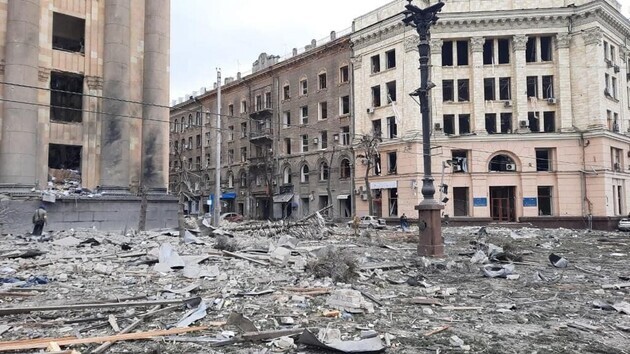Seven Lessons from the Past for Cities in the Future

article by Myroslav Kosheliuk, Urs Thomann, Iryna Ozymok
Although the air raid still tears the air in most Ukrainian cities and communities, it is necessary to discuss their restoration and development today. This makes sense in both moral and practical ways. Now we can hardly imagine what the post-war Mariupol, Kharkiv or Bucha will be like, but the war offers a chance to eradicate the Soviet legacy in its numerous features. Focusing on the best international practices, one should also take into account the already accumulated experience of their adaptation by Ukrainian municipalities. These lessons of the past can serve as the basis of the Ukrainian culture of sustainable urbanism.
Ukrainian cities should stick to self-governing
The decentralization reform in Ukraine has significantly contributed to the strengthening of municipalities and their capabilities. And during the war, local self-government bodies (SGBs) also gained invaluable experience in solving infrastructure (restoring the life of cities after destruction), social (accommodation and adaptation of IDPs), economic problems (relocation of enterprises), etc., necessary for the future restoration of cities.
Self-government as the citizens' right to manage the city is in fact a precondition for modern urbanism. Therefore, the ownership of a restored country should belong to people and municipalities , and not just to the state, certain politicians or international organizations. We need a big-scale construction, but on consolidated basis.
The post-war period risks may include the curtailment of decentralization for the sake of quick solutions. While quick actions are proven effective, any attempt to narrow the role of the SGBs in the restoration process would be a big mistake. Moreover, in the generally war-torn economy and even more so in the cities destroyed by the occupiers, local governments will not be able to quickly restore their own financial resource base. A significant part of the recovery programs will be implemented centrally at the expense of state and donor funds. Unfortunately, even before the war, the practice of financing local projects through the State Regional Development Fund and other state programs drew a lot of criticism due to the growing tendency of sidestepping local governments in process of decision-making. Therefore, today we need to revise the practice of applying these financial mechanisms.
New culture of urban development
The abovementioned does not imply that local officials should be the ultimate authority. The risks of incompetence and corruption in decision-making at the local level are at least not lower than at the central one. The state must fulfill its inherent function - the revision of the rules, procedures, and standards, which in fact should become the basis of a new culture of urban development.
Both the system of basic urban planning documentation and the post-Soviet urban development culture, focused on the extensive expansion of cities outwards a single center with two types of outskirts sleeping districts and industrial zones, - need to be updated. Recently this approach has begun to change. Examples include new approaches to city development in Vinnytsia, new types of multifunctional centers as UNIT City and an IT park in Lviv, and the first steps towards the development of polycentric Lviv and Kyiv agglomerations.
The transition to a new model of urban development also implies strengthening the position of the bearers of this culture - representatives of the new urban community, which yet lacked an institutional basis in the form of modern educational and research institutions . It is necessary to strengthen communication between “urbanists” and “decentralizers”, communities that still communicate mainly on different platforms and do not fully realize their interdependence in the implementation of high-quality urban development projects.
However, there is a risk that the old culture and its legal and institutional framework, which was largely based on a certain consensus of developers and corrupt officials, will keep on prevailing. The expected need to quickly resolve urgent problems can provoke “quick and easy” but false solutions, and the interest in controlling and spending a large amount of resources that will obviously be used in post-war reconstruction creates background for the restoration of corruption schemes.
Cities for people, or human-centric ones
The implementation of the “right to the city” acquired by residents as a result of decentralization has become the prevailing trend after 2014. The comfort rating of cities became almost the main rating, where cities competed before the war. Examples of creating high-quality public space, prioritizing public transport and renovating it accordingly, promoting cycling and improving pedestrian accessibility, and increasing the urban environment inclusiveness could be found in almost every pre-war community, although sometimes they were implemented with certain mistakes and without full understanding. Every year Vinnytsia, Ivano-Frankivsk, Lviv and other cities became more and more European. Mariupol showed improvements every year.
It is expected that even a short experience of living abroad among millions of Ukrainians today will force the request to the authorities of their cities for “Europeanism”. Experts from among IDPs, who are now acquiring valuable professional experience in Western European countries, will help to satisfy it. Their involvement will also boost women participation in urban development, which was scarce before the war.
We must take into account that the war not only destroyed the cities, but also disabled many people. Even today they say that post-war Ukraine will see many people with disabilities, particularly young adults. Therefore, taking into account the accessibility requirements will demand even more attention from all "rebuilders". And here Slavutych is worth mentioning, since before the war it strived to create a laboratory of accessibility.
However, there is a risk that solutions providing the comfort (or livability) of cities can become only a “decorative urban elements”, and cities will further be developed with an outdated modernist approach good for cars, not for people.
Energy efficient and therefore more independent
The threats of climate change served as the best driver for global energy efficiency initiatives. Their local implementation is closely related to the solutions mentioned above - the multifunctionality of neighborhoods to reduce traffic, prioritizing public transport, and increasing pedestrian accessibility. It also provides for new approaches to construction, heat supply, municipal solid waste management, the introduction of the "green economy" principles, etc.
In the pre-war years the implementation of energy efficiency approaches in Ukraine was hampered by a lack of resources and, at times, political will to make unpopular decisions. But now we’re armed with the expertise of cities that have joined the European initiative "Covenant of Mayors" and cooperated with the Association of Energy Efficient Cities of Ukraine, the experience of implementing the European Energy Award initiative in Vinnytsia, Zhytomyr and other cities, examples of the implementation of sustainable mobility solutions, the launch of Energy Efficiency Fund, etc. As part of the large-scale Green Deal initiative, new opportunities for cooperation with the European Union were considered.
Now all this has taken on a special meaning. After Russia's invasion of Ukraine, reducing dependence on Russian energy products becomes extremely relevant not only for us, but for the whole Europe and the world.
Compliance with energy efficiency, as well as other principles of environmental protection (air quality, water quality, biodiversity, climate change) should become a strict rule of post-war recovery. Often a situation calls for immediate action, and quick, even temporary solutions will seem most relevant. Without questioning the need for such solutions, it should be possible to adjust them taking into account energy efficiency issues, especially when they tend towards the medium and long term impact.
Smart tech for better cities
The widespread introduction of digital technologies is a call of the time, and Ukraine kept pace with it. During the pre-war years, the state has made significant progress in digital transformation: the Diia project has been implemented, a rising number of administrative services have gone online, and the practice of e-governance has spread. The wide use of digital solutions has contributed to increased transparency in decision-making and prevention of corruption.
There was an active introduction of smart technologies at the local level, in particular, geographic information systems, open data systems, electronic document management, etc. New technologies were introduced for municipal’ public safety systems, traffic management, and passenger fares payment. Since 2021, the so-called "Internet subvention" has been introduced, intended to facilitate the widespread access of municipalities to the Internet.
In post-war cities such solutions will be even more in demand. Although the ideas of fully automated "smart cities" has somewhat slackened around the globe, it is hard to imagine modern cities without integrated digital solutions in all areas of municipal management. However, they are costly, and we have little experience in implementing them locally. At the same time, it is important to ensure the reliability of such solutions, since the threat of cyber-attacks will remain even after the war.
Community involvement as a key to success
In modern European cities public discussion is a necessity for most projects, and more often a prerequisite, defined by law. Everywhere local authorities cooperate with the public sector and delegate part of their functions to non-governmental organizations. In general, every European city is not just a group of inhabitants, but a community that is actively involved in determining the vectors of its development.
The Revolution of Dignity has significantly driven the development of civil society in Ukraine. According to the seventh municipal survey, volunteers had the highest level of public support - 63%, non-governmental organizations (NGOs) - more than 50%. The public sector played an active role in the reforms taking place in the country and actively participated in the local changes in particular.
Decentralization has increased the involvement of citizens in the community life. The practice of public budgets, the obligatory public discussion of a number of local development documents, the practice of creating a network of citizens’ self-organized bodies, etc., have become widespread. To exemplify positive experience of cooperation between local authorities and the public sector, one can name the City of Senses (“Misto zmistiv”) platform in Vinnytsia, and Prompylad in Ivano-Frankivsk, which became the place for uniting authorities and the community. The practice of making local communities’ funds, which development was facilitated by ISAR "Ednannia ", has also become widespread.
Volunteer organizations and community initiatives have quickly responded to wartime challenges, and public confidence in them is growing. In many cities, effective alliances have been formed between SGBs and local NGOs. Therefore, it is hard to imagine that the restoration of cities will take place without a high level of social activity and all possible forms of public involvement.
However, politicians and officials are often prone to make important decisions without involving the public, justifying this with a lack of time. In fact, here we deal with the desire to single-handedly receive public dividends from the implementation of certain programs. Such risks are relevant during the recovery period. On the other hand, sometimes NGOs really lack competence, and in some cases they block decisions being biased by certain interests. Therefore, it is crucial to determine the legal basis for creating effective platforms for public involvement (for example, draft law No. 7283 “On Local Self-Government in Ukraine”, registered with the Verkhovna Rada).
Cities of the future: strategic planning
The introduction of strategic planning for local development is another achievement of decentralization. Having received the resource and the right to use it, along with the responsibility for their own development, the municipalities became involved in the process of building their own strategies. According to the Ministry of Communities and Territories Development, at the beginning of 2022, 617 muncipalitieses (that is, almost half) had prepared and approved local development strategies. It was assumed that availability of a strategy or a strategic plan would become mandatory for the municipalities.
Obviously, many previously developed strategies will require at least updating, and this will take a while. However, it will be really necessary to review the vision and key priorities, at least in the short- and medium-term.
The war will change many of the demographic, economic, social and other initial benchmarks for the local development, which must be taken into account. The desire to simply restore everything that is now destroyed, without reconsidering the needs of society, creates the risk of inefficient use of public investment.
In general, when we talk about the future of Ukrainian cities, it is so hard-won that we have no right to muck around without respect for those who fought for it. The pre-war experience of introducing European urban ideas is what we can rely on. We only need to be more resolute in order to get rid of the remnants of post-Soviet approaches.
The content of this article is the sole responsibility of its authors and cannot be viewed as the one reflecting the views of the Council of Europe and its member states.
Read this article in russian and Ukrainian at the links.
Please select it with the mouse and press Ctrl+Enter or Submit a bug













.jpg)
.jpg)
.jpg)
.jpg)
 Login with Google
Login with Google